|
|
Creator | Title | Description | Subject | Date |
| 26 |
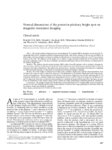 |
Couldwell, William T. | Normal dimensions of the posterior pituitary bright spot on magnetic resonance imaging: Clinical article | Object. The normal pituitary bright spot seen on unenhanced T1-weighted MRI is thought to result from the T1-shortening effect of the vasopressin stored in the posterior pituitary. Individual variations in its size may be difficult to differentiate from pathological conditions resulting in either ab... | | 2014-01-01 |
| 27 |
 |
Couldwell, William T. | Technique for methyl methacrylate cranioplasty to optimize cosmetic outcome | Background: Cranioplasty aims to reconstruct skull defects from fractures, decompressive craniectomies, tumors, and congenital anomalies in a cosmetically acceptable manner. We present a technique in methyl methacrylate cranioplasty that gives excellent cosmetic results by maintaining patient's calv... | | 2014-01-01 |
| 28 |
 |
Couldwell, William T. | Role of CCM1 loss-of-function-induced endothelial-to-mesenchymal transition in the development of cavernous malformations | Cerebral cavernous malformations (CCM) occur in two variants: sporadic and familial. Mutations in three genes-CCM1, CCM2, and CCM3-play a role in both subtypes, with mouse models showing the development of multiple cavernous malformations in animals with loss of function in any of these three genes.... | | 2013-01-01 |
| 29 |
 |
Couldwell, William T. | Surgical treatment of craniofacial fibrous dysplasia in adults | Craniofacial fibrous dysplasia is a rare disorder that may require neurosurgical expertise for definitive management; however, surgical management of FD in adult patients is uncommon. Although other therapies have been shown to slow progression, the only definitive cure for adult craniofacial FD is ... | | 2014-01-01 |
| 30 |
 |
Couldwell, William T. | Surgical fidelity: comparing the microscope and the endoscope | Background: Both the microscope and the endoscope are widely used as visualization tools in neurosurgery; however, surgical dexterity when operating with endoscopic visual control may differ. The aim of this study was to compare the surgical fidelity when using each of these visualization tools. Met... | | 2013-01-01 |
| 31 |
 |
Couldwell, William T. | Intracranial hypotension in the setting of concurrent perineural cyst rupture and subarachnoid hemorrhage | Although most patients with intracranial hypotension typically present with headaches, the rest of the clinical spectrum is characteristically non-specific and often quite variable. In a patient with concurrent pathologies that can produce a similar clinical picture, a high index of suspicion must b... | | 2013-01-01 |
| 32 |
 |
Jensen, Randy Lynn | Treatment-related brain tumor imaging changes: so-called "pseudoprogression" vs. tumor progression: Review and future research opportunities | Background: Glioblastoma multiforme (GBM) has a dismal prognosis despite aggressive therapy. Initial diagnosis and measurement of response to treatment is usually determined by measurement of gadolinium-enhanced tumor volume with magnetic resonance imaging (MRI). Unfortunately, many GBM treatment mo... | | 2013-01-01 |
| 33 |
 |
Couldwell, William T. | Delayed vasospasm after removal of a skull base meningioma | Cerebral vasospasm is a well-known clinical entity associated with subarachnoid hemorrhage and traumatic brain injury [1,2]. In rare instances, vasospasm has been reported to occur after tumor resections, more specifically, after skull base tumor removal [3-5]. We report a rare case of a patient pre... | | 2012-01-01 |
| 34 |
 |
Couldwell, William T. | Pituitary models | Pituitary tumor animal models provide researchers a microenvironment that simulates the clinical situation; however, in comparison with astrocytoma and meningioma tumor research where intracranial xenograft transplantations are increasingly being used to test various therapeutic modalities, in vivo ... | | 2013-01-01 |
| 35 |
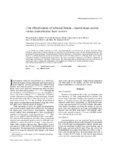 |
Bisson, Erica F. | Cost effectiveness of subaxial fusion-lateral mass screws versus transarticular facet screws | As health care reform continues to evolve, demonstrating the cost effectiveness of spinal fusion procedures will be of critical value. Posterior subaxial cervical fusion with lateral mass screw and rod instrumentation is a wellestablished fixation technique. Subaxial transarticular facet fixation is... | | 2012-01-01 |
| 36 |
 |
Schmidt, Meic H. | Isolated intramedullary neurosarcoidosis of the thoracic spine: case report and review of the literature | Sarcoidosis can involve the central nervous system in approximately 5-15% of cases. Any part of the nervous system can be involved, so presentation can be quite varied. Isolated disease of the spinal cord is even less common and reports are limited to single cases and small series. Although in the s... | | 2012-01-01 |
| 37 |
 |
Schmidt, Meic H. | Is vertebral augmentation the right choice for cancer patients with painful vertebral compression fractures? | Cancer-related fractures of the spine are different from osteoporotic ones, not only in pathogenesis but also in natural history and treatment. Higher class evidence now supports offering balloon kyphoplasty to a patient with cancer, provided that the pain is significant in intensity, has a position... | | 2012-01-01 |
| 38 |
 |
Schmidt, Meic H. | Cervical spine metastases: techniques for anterior reconstruction and stabilization | The surgical management of cervical spine metastases continues to evolve and improve. The authors provide an overview of the various techniques for anterior reconstruction and stabilization of the subaxial cervical spine after corpectomy for spinal metastases. Vertebral body reconstruction can be ac... | | 2012-01-01 |
| 39 |
 |
Couldwell, William T. | Surgical approaches for resection of vestibular schwannomas: Translabyrinthine, retrosigmoid, and middle fossa approaches | Surgical removal remains one of the key treatment modalities for vestibular schwannomas. A team approach between a neurotologist and a neurosurgeon offers the patient the expertise of both specialties and maximizes the chances for an optimal outcome. Vestibular schwannomas can typically be resected ... | | 2012-01-01 |
| 40 |
 |
Couldwell, William T. | Norman Dott, Gerard Guiot, and Jules Hardy: key players in the resurrection of transsphenoidal surgery | Developed over a century ago, the introduction of the transsphenoidal approach to access lesions of the pituitary gland and sella turcica has transformed the field of neurosurgery, largely due to the work of Oskar Hirsch and Harvey Cushing. Furthermore, its use and modification in the early 1900s wa... | | 2012-01-01 |
| 41 |
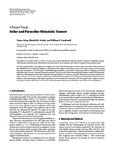 |
Couldwell, William T. | Sellar and parasellar metastatic tumors | The sellar and parasellar (SPS) region is a complex area rich in vital neurovascular structures a first manifestation of a systemic malignancy. Metastases to this region are rare; breast cancer is the most common source among those that metastasize to the SPS region. Ophthalmoplegia, headache, retro... | | 2012-01-01 |
| 42 |
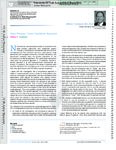 |
Couldwell, William T. | Giant pituitary tumor combined approach | Nishioka et al. have provided a review of 29 patients with large pituitary adenomas who underwent surgery through a simultaneous transsphenoidal and transcranial approach at their institution during a 7-year period. Large adenomas with hourglass constriction, complex lobulations, and asymmetric exte... | | 2012-01-01 |
| 43 |
 |
Couldwell, William T. | Efficacy of clip-wrapping in treatment of complex pediatric aneurysms | Purpose: Pediatric aneurysms (PAs) are distinct from their adult counterparts with respect to typical location, aneurysm type, and known predisposing risk factors. Many strategies have been employed to treat PAs, but, although it has been used frequently in adults, clip-wrapping in pediatric patient... | | 2012-01-01 |
| 44 |
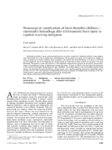 |
Garber, Sarah | Neurosurgical complications of direct thrombin inhibitors - catastrophic hemorrhage after mild traumatic brain injury in a patient receiving dabigatran | Dabigatran etexilate is an oral anticoagulant that acts as a direct, competitive thrombin inhibitor. Large randomized clinical trials have shown higher doses of dabigatran (150 mg taken twice daily) to be superior to warfarin in terms of stroke and systemic embolism rates in patients with nonvalvula... | | 2012-01-01 |
| 45 |
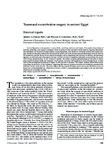 |
Couldwell, William T. | Transnasal excerebration surgery in ancient Egypt: Historical vignette | Ancient Egyptians were pioneers in many fields, including medicine and surgery. Our modern knowledge of anatomy, pathology, and surgical techniques stems from discoveries and observations made by Egyptian physicians and embalmers. In the realm of neurosurgery, ancient Egyptians were the first to elu... | | 2012-01-01 |
| 46 |
 |
Patel, Bhupendra C. | Lateral orbital wall approach to the cavernous sinus: laboratory investigation | Object. Lesions of the cavernous sinus remain a technical challenge. The most common surgical approaches involve some variation of the standard frontotemporal craniotomy. Here, the authors describe a surgical approach to access the cavernous sinus that involves the removal of the lateral orbital wal... | | 2012-01-01 |
| 47 |
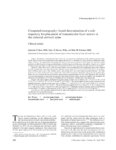 |
Bisson, Erica F. | Computed tomography-based determination of a safe trajectory for placement of transarticular facet screws in the subaxial cervical spine: Clinical article | Object. Placement of transarticular facet screws is one option for stabilization of the subaxial cervical spine. Small clinical series and biomechanical data support their role as a substitute for other posterior stabilization techniques; however, the application of transarticular facet screws in th... | | 2012-01-01 |
| 48 |
 |
Garber, Sarah | Spinal arteriovenous fistulas in children with hereditary hemorrhagic telangiectasia: report of 2 cases | Hereditary hemorrhagic telangiectasia (HHT) is an autosomal dominant angiodysplasia with high penetrance and variable expression. The manifestations of HHT are often age related, and spinal arteriovenous fistula (AVF) may be the initial presentation of HHT in young children. Because spinal AVFs are... | | 2012-01-01 |
| 49 |
 |
Kestle, John R. W. | Abdominal binders | Sklar and colleagues2 describe their experience managing "over-shunting headaches" with an abdominal binder. Seventy children with over-shunting headaches complied with application of a binder for about 1 month. In 61 patients (87%), the headaches "greatly improved or went away." This headache relie... | | 2012-01-01 |
| 50 |
 |
Dailey, Andrew T.; Brodke, Darrel S. | Inter- and intraobserver reliability of computed tomography in assessment of thoracic pedicle screw placement | Study Design. Reliability study of computed tomography imaging in 12 cadaver specimens instrumented with titanium or stainless steel thoracic pedicle screws. Objective. To evaluate inter- and intraobserver reliability of computed tomography scan in determining the accuracy of thoracic pedicle sc... | Thoracic pedicle screw; Placement; Assessment; Computed tomography | 2003 |

























